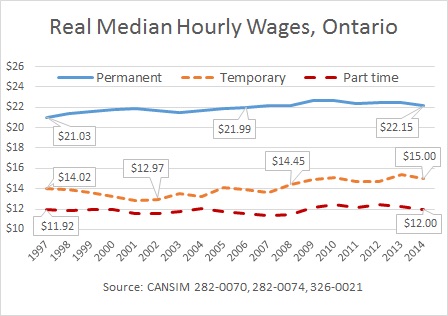The Ontario government has launched a review of their Labour Relations Act and Employment Standards Act. The premise is that the workplace has changed, and Ontario labour law no longer does as much as it should to protect vulnerable workers.
The Workers’ Action Centre in Toronto took this opportunity to document the myriad ways that workers are left behind, and make 47 concrete recommendations to improve legislative protections.
What’s unique about this report is that workers’ voices are central. Throughout the report links are made between the lived experiences of workers, current labour market statistics, and thoughtful recommendations to make workers’ lives better.
One huge problem in precarious work is the downloading of risk to workers. This is done through just-in-time scheduling, overuse of part-time and temporary employment relationships, and employee misclassification. Too many “workers” are classified as self-employed, and this practice has spread into a surprising number of sectors.
A 2010 review of the construction sector in Ontario found that misclassified independent contractors cost the province $1.4 billion to $2.4 billion in WSIB, income tax, CPP, and EI payments. This doesn’t even begin to touch on the lost wages and benefits to workers. The Workers’ Action Centre report offers suggestions that put the legal onus on an employer to prove there is no employee-employer relationship, which could help stem this trend in precarious work.
Another key issue highlighted by the report is “Equal Pay for Equal Work.” One might be forgiven for thinking that this has to do with the gender wage gap (well, it’s related, as we’ll see). Workers in temporary and part-time positions earn far less money than their permanent full-time counterparts. Workers in temporary positions tend to be young workers, women, and racialized workers (which is a factor in the gender and racialized worker wage-gap).
This answers the question of why we care about part-time work when the vast majority of workers “choose” to work part-time. It’s because part-time and temporary workers are overwhelmingly low wage, and along with that tend to have much weaker bargaining power in all aspects of their employment.
I absolutely encourage anyone who is putting together their own organization’s response to read this report, and to support the recommendations found within. Precarious workers are counting on us to make sure the Employment Standards Act recognizes their lived reality. This is not only a show of basic solidarity, but the base upon which all workers’ protections stand.




